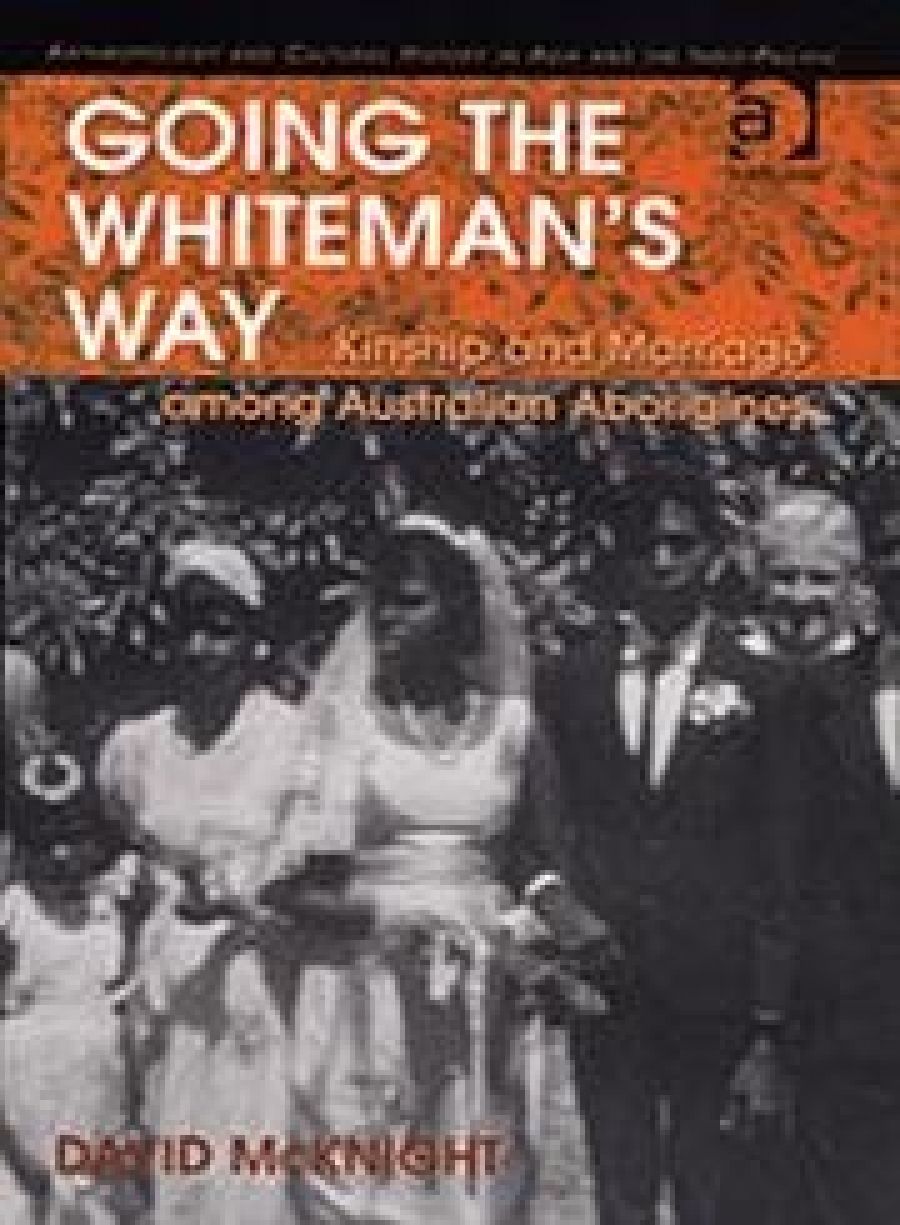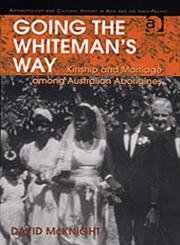
- Free Article: No
- Contents Category: Indigenous Studies
- Review Article: Yes
- Article Title: After the Elegy
- Online Only: No
- Custom Highlight Text:
David McKnight made the first of many field trips to Mornington Island in 1966, when the old people could still remember how it was before the white men came. The Lardil largely escaped the violence that accompanied white intrusion, and had kept possession of their land, although in time they were made to share it with survivors from the region. A mission, established in 1914, had preserved them from further predation, but at a cost: hunter-gatherers were rounded up and made to live cheek-by-jowl in a ‘supercamp’ close by the mission, and their children were taken to be raised and educated by the missionaries, with only casual contact with their parents.
- Book 1 Title: Going The Whiteman’s Way
- Book 1 Subtitle: Kinship And Marriage Among Australian Aborigines
- Book 1 Biblio: Ashgate, £45hb, 284pp
- Book 1 Cover Small (400 x 600):

- Book 1 Cover (800 x 1200):

Through long intimacy, McKnight came to admire the resilience and ingenuity with which the Mornington Islanders responded to their changing colonial reality. He also came to understand how outside interventions, including benevolent ones welcomed by the recipients, could reverberate unpredictably, often destructively, through the community. His book From Hunting to Drinking: The Devastating Effects of Alcohol on an Australian Aboriginal Community (reviewed in these pages by Travis Cutler in October 2004) traced the Islanders’ precarious history of scrambling to accommodate those interventions. That book ends with their surrender to the poisoned gift of alcohol and the extinction of their distinctive way of being: ‘Drinking, to people who are ... in their twenties and thirties, is a way of life, if not the only way of life ... What they [now] know best is the canteen and the power of White people and money.’
I read From Hunting to Drinking as McKnight’s obituary for a people he had loved for the wariness, humour and toughness of spirit with which they had accepted the ambiguous gifts of white men – until they embraced that final, lethal gift. After an elegy, what can be left to say? I was therefore surprised to be handed the book under review. The tragic parabola of Mornington Island’s post-contact history is crammed into the opening chapter: a chapter that ends abruptly with the mid-1970s, the fatal years during which the mission withdrew, the canteen was opened, and the plunge into destruction began. Going the Whiteman’s Way announces itself to be a formal study of Lardil kinship and marriage: the third of four volumes designed to sum up McKnight’s impressive contribution to anthropology. Its subject is the esoteric rules of descent and affinity that control the allocation of marriage partners – the fine-meshed grid of laws within which the Australian Aboriginal slice of humanity has chosen (as I thought perversely) to cage itself.
And at first, the Lardil ‘rules’ seem perverse indeed. We watch a female infant being pledged to marriage by being placed in her adult ‘husband’s’ lap. We scarcely have time to come to terms with the distasteful idea of an old man enjoying marital rights over a nubile girl who will have absolutely no choice in the matter when we are told that boy babies can acquire ‘husbands’, too, in exactly the same way; that the ‘husbands’ will also address these male infants as ‘wife’; that the lap-providers rarely marry their infant female ‘spouses’ and that this small ritual is not or not always an engagement to marry but the symbolic affirmation of a relationship of special responsibility between this adult and this child, not unlike the powerful institution of co-godparenthood in, say, Mexican Indian cultures. We had been looking in the wrong direction.
The rigidities of Lardil kinship laws melt and waver on closer examination. Any one individual stands in so many lines of affiliation at any one time that (beyond commitment to the immediate blood kin, which is immutable) actual obligations are open to negotiation. ‘The kinship system’ is revealed to be not so much a system as an idiom through which alliances can be established and renegotiated, potential conflicts resolved or exacerbated, and ambition pursued. For me, ‘the system’ is most like a jungle gym, with the immediate structures firm but multiple alternative routes for the adventurous lacing the wider territory. In an engaging note, McKnight recalls plaintively asking, in a moment of awful confusion, ‘Well, who may one marry?’ to be answered good-naturedly: ‘That’s what we would like to know.’ They will find out not by consulting the rulebook, but by protracted discussion. They will also appeal to the elders, whose knowledge of who married whom and who raised which children was extensive and time deep – rather like the rural matriarchs of my childhood, who were extensive genealogy-and-gossip libraries in themselves.
Then McKnight tosses us in at the deep end by presenting us with verbatim reports from two meetings called to resolve a marriage dispute in 1967. The first meeting is between elders troubled by the possibility that two young people gone to the mainland will marry there and that the marriage would be ‘wrong’. Initially, the speeches are a blur of strange terminologies and indecipherable crises, but then we begin to ‘hear’ what is being said: the to-ing and fro-ing of people knowledgeable, powerfully concerned, but now bereft of authority. The glum consensus is that the marriage will happen anyway; that it must be accepted – but the young man must be thrashed when he next shows his face on the island. Thus the elders strive to negotiate honourable terms for their evident defeat.
The next meeting is larger, with elders, members of the young couple’s families, the resident missionary, the Reverend Doug Belcher playing umpire and McKnight earnestly recording in the corner. The young man, intent on ‘going the whiteman’s way’, has appealed directly to Belcher. He wants to marry (‘wrongly’) on the island. Belcher wants a just, non-violent and final solution. He listens, questions, and exhorts the several passionate interest groups to be ‘fair’. But this is not about abstract concepts such as ‘fairness’, but a painful accounting of whose rights, now and in the future, might be jeopardised by this irregular alliance. Although … is this marriage really ‘wrong’? Might there not be precedents to cover the case? There follow Herculean feats of recall and some fine Jesuitical discriminations to find a way out of the crisis – a crisis added to by the intransigent grandmother Topsy, desperate to keep possession of the grandchildren fathered by the young man with her deceased daughter in an earlier relationship. Topsy’s determination happens to conflict with both Aboriginal and Australian legal thinking, but she is treated tenderly. Who can know what will happen to children when young people ‘go the whiteman’s way’?
McKnight dedicates this marvellous book to two Mornington Islanders now dead, and to the Reverend Belcher, the long-serving missionary we see struggling to adjudicate the second meeting. That is fitting. The best anthropologists stand between two mutually incomprehensible worlds, interpreting each to the other. McKnight makes us see that these people say and do surprising things because their values are indeed different from ours, and differently arranged. But he also shows us that they are our kin, striving to manage familiar problems in time-tested ways particular to themselves.


Comments powered by CComment